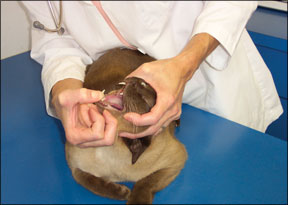Dear Elizabeth, I am an elderly cat owner. Im old and so is my girl, Pearl. Over the years, we have gotten used to many changes in visits to our veterinarian. For example, Pearls “yearly shot” is no longer annual, and screening lab work is an expected part of her exam. These changes have been explained to me and I accept them, but there is one thing I just cant get used to. Years ago our vet would take a few minutes on the exam table to clean Pearls teeth. Pearl didnt like it much, but the vet was able to take care of her teeth without anesthesia right in the office. Now, that office procedure just isnt offered; instead our vet is recommending anesthesia for dental cleaning. Pearl has visible tartar on her teeth, but why cant my vet just clean them in the exam room?
As you know, I started out as a “free-range” cat, so I didnt have the benefit of regular veterinary care growing up. Now that I am a Cornell Cat, I cant turn around without bumping into a veterinarian. When I first arrived at the Feline Health Center, I received a complete physical examination. Now, Im a fairly cooperative patient – but I am a calico and used to calling my own shots, so when it came to the oral exam I had to put my paw down. I think I allowed about a four second glance into my mouth before putting an end to the process!
There was just no way that my friends in the white coats could do a complete oral exam. Veterinarians have their methods, so apparently they did catch a glimpse of the area under my tongue

Bev Caldwell
288
and get a general impression of my dental health, but I can tell you there was no way I was going to let them inspect each of my teeth. Now consider how much worse that exam would go if I had some pain associated with a tooth or a tender spot somewhere in my mouth. Every cat is different, so I realize that some of my cousins would be more compliant. Some, like Pearl, would even allow their veterinarian to use a fingernail or (shudder) a tool to chip tartar off the surface of their teeth. This brings up the second part of our query: Is this kind of dental attention beneficial?
The tartar that you can see is clear evidence that Pearl has a buildup of food material, bacteria and minerals on her tooth surfaces. This material covers the enamel of the tooth crown and looks terrible, but it is only a sign of the real trouble occurring under the gum line. Just as in you humans, cats teeth are put at risk by inflammation and bacterial action under the gingiva, or gum line. This so-called subgingival disease can result in abscess formation, pain and tooth loss and possibly even predispose us to disease at distant sites in the body.
A False Sense of Accomplishment?
When the gross (and I do mean gross!) material is chipped off the surface of the tooth, nothing is done to the real culprits under the gingiva, and worse, we are left with a false sense of accomplishment. Dental cleaning on an awake cat is aesthetic only; it is like dusting the woodwork while ignoring the termites! A much more thorough job – including cleaning under the gingiva, cleaning both the inside and outside surfaces of the teeth and doing a final polishing to help discourage further tartar buildup – can all be done on a cat under anesthesia.
So, even if your girl Pearl is a better patient than I am and would allow “dusting of her woodwork” on the exam table, my best advice is to go for the termites! Love, Elizabeth.



